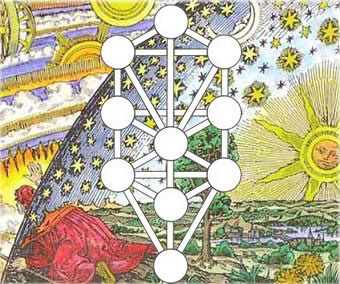SATURDAY, JULY 26, 2008
Gnostic Parallels In The Qabalah

As a student of both Gnosticism and Qabalah, I began to find many similarities between the two, and wondered just how deep the parallels went. Indeed, it made me question if the Qabalah was influenced by Gnosticism, which even the Qabalistic scholar Gershom Scholem wondered in his many excellent books on the subject. It seems likely that this is so, at least in the Lurianic school of Qabalah, but for now I will content myself with merely pointing out the parallels and letting my readers come to their own conclusions.
- God is conceived of as beyond the Three Negative Veils of Existence, (Limitless Light, Limitless, and Nothing), as the Unmanifest, in the Qabalah. Likewise it was common Gnostic principle (as well as being a general approach in mysticism as a whole [see the Cloud of Unknowing, for example]) to define God in negative terminology.
- While the above is true, God was also seen as part and parcel of the entire manifest universe, while also being beyond the Three Negative Veils. This is calledpanentheism, believing the universe to be part of God, but not all of God, which is in stark contrast to pantheism. Of course, there were many Gnostics who claimed definitively that the world was not in the least bit divine, but there were also many others who believed otherwise - the Valentinians in particular. They shared a predominantly panentheistic view. This can also be found in the Qabalah, where God is present in all the Sephiroth, and yet there is also part of him that is Unmanifest, beyond the Veils.
- The process of emanation in the creation process ("emanationist cosmogony") is part and parcel of, at the very least, Sethian and Valentinian belief. It is a typical point that, in a sense, defines Gnosticism (though, of course, not all Gnostics adhered to this, but this is pushing the term to its most open and inclusive). At the very least, the Sethians are the only group to actually call themselves Gnostics, and since they believed this, it is the most definitive source, in terms of scholarship, for defining the belief. The Qabalah shares this cosmogony, with emanating Sephiroth instead of Aeons. Indeed, the Aeons often numbered 10, the number of the Sephiroth.
- God of the Manifest Universe, either seen in Chokmah or Kether, is not the "real God" - you see a beared man in Chokmah (traditional "man in the clouds" god), or a bearded man in profile in Kether, showing you can only see one side of God. This is very similar to the conception of God throughout Gnostic myth, with the God of Chokmah or Kether (depending on your source and personal inclination), who is the "Creator God", being equated as the Demiurge.
- Gnosticism espouses a belief in a Divine Spark in Man. Qabalah also espouses this belief (via the Yechidah, etc.). See here and here for Qabalistic passages by the Baal Shem Tov on the Divine Sparks.
- Gnosticism teaches us that this world is a fallen one (sometimes likened to a prison, which the Qabalists would not necessarily have agreed with), with the Divine Sparks trapped inside. It must be raised up and restored to its original condition. This is a pivotal belief in the Qabalah, which focus on the Tiqqun ha-Olam, the Restoration of the World. This usually takes the form of Malkuth being fallen and requiring reunion with Tiphareth (see here for my Qabalistic Cross material on Tiqqun as an illustration of this).
- There is a feminine form of Divinity in Gnosticism, which is termed Sophia. The Qabalistic equivalent, often used by many modern Gnostics, is the Shekinah. Sophia was once one of the primary emanations, but has now become trapped in the physical. This is mirrored in the Qabalah, where Sophia (or Barbelo in her higher Sethian aspect) lies in Binah, but her fallen counterpart lies in Malkuth. Interestingly enough, Sophia is Greek for "Wisdom," whileChokmah is Hebrew for "Wisdom". Some Qabalists would attribute the Demiurge to Chokmah (while others will choose Kether or even Chesed), and the Demiurge is typically linked to Saturn, which is attributed to Binah. Thus we have a kind of reversal of attributions of Sophia and Demiurge between these two Sephiroth in the Qabalah.
- The most important principle about Gnosticism is Gnosis, experiential knowledge of the Divine. While the Qabalah does not have a direct equivalent, Gnosis is usually translated as "Knowledge", with a potential equivalent being the Hebrew Da'ath, also translated at "Knowledge". To access the Supernal Realm the Qabalist must peruse Da'ath, or, to put it another way, Gnosis allows us to experience the heights of Divinity. This is a fundamental hidden principle to Qabalah.
These are but a few of the parallels I've found between these two systems, which, as both a Gnostic and a Qabalist, have allowed me to use them together without contradiction (and have allowed me to explain Qabalistic ideas in Gnostic terms, or Gnostic ideas in Qabalistic terms). There are many more parallels, including theSepher Yetzirah and Sepher ha-Bahir. I will be exploring these in a more indepth article on this matter in the future.
No comments:
Post a Comment